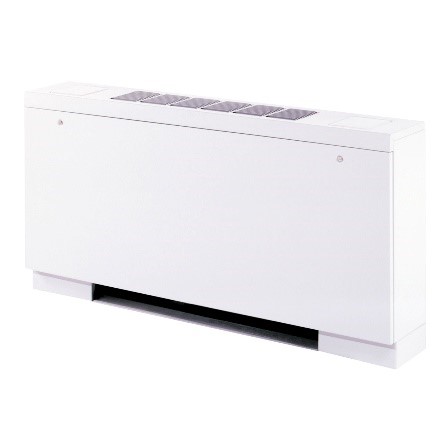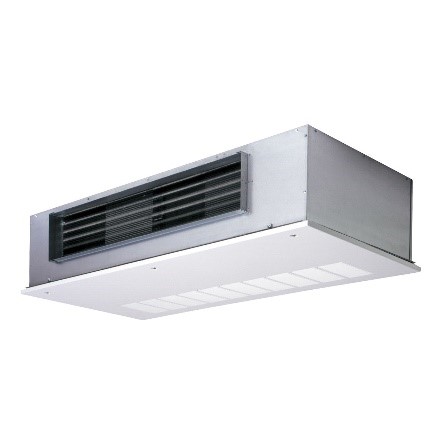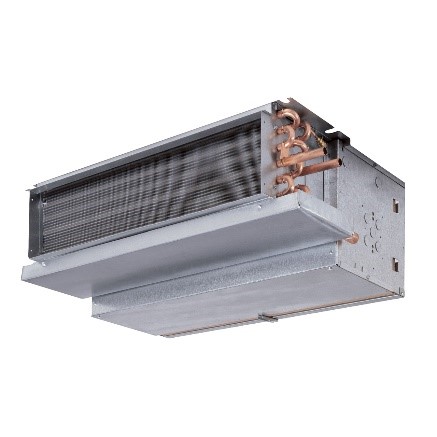Intro to Hydronic Fan Coil Units (FCUs) for Commercial HVAC Design

In HVAC system design, hydronic fan coil units (FCUs) are a popular yet sometimes misunderstood component. Understanding how hydronic fan coil units work and where they function best may help architects and building owners make better early-stage decisions when assessing HVAC systems.
In this blog, we will go over the fundamentals of hydronic fan coil units, how they function, their benefits and drawbacks, and which commercial projects gain the most from their use.
What Is a Hydronic Fan Coil Unit?
A hydronic fan coil unit is a simple HVAC device that consists of a fan and a heating and/or cooling coil. It draws in room air, conditions it by passing through the coils supplied with either hot or cold water, and then distributes the air back into the space. Fresh outdoor air is often, but not always, introduced on the return side of the fan coil unit to provide the required ventilation air to maintain good indoor air quality.
Hydronic fan coil units are generally part of a larger building HVAC system that supplies the necessary hot and cold water. Hydronic fan coil units come in two primary types:
- 2-pipe systems: Provide either heating or cooling depending on the season, but cannot provide simultaneous heating and cooling in different areas of the same overall system.
- 4-pipe systems: Provide heating or cooling on demand depending upon the needs of the zone served, regardless of the season.
These units are typically installed in ceilings, closets, or floors and allow for room-by-room temperature control. Hydronic fan coil units can be either exposed with finished cabinets, partially concealed with room accessible components or fully concealed requiring access doors or closets. Depending on the type of unit selected, they can be either ducted, or non-ducted as is the case with cabinet mounted units that are not concealed.



How Do Hydronic Fan Coil Units Work?
Hydronic fan coil units operate independently within a centralized HVAC system. Each unit is connected to a central chiller and/or boiler, which provides the chilled or hot water to circulate through the coil(s) in the unit.
Here’s how they function:
- air from the room is drawn into the unit.
- the fan moves air across a coil containing either hot or chilled water.
- the conditioned air is then delivered into the space, and
- a thermostat or control system adjusts the fan speed and water flow to maintain set temperatures.
Because each unit serves a specific zone, they provide a high level of individual temperature control, with precise air and water delivery to meet the loads of the zone.
What are the Pros and Cons of Hydronic Fan Coil Units
Pros
- Zoning Flexibility: Individual spaces can be controlled separately making them ideal for buildings with diverse occupancy patterns.
- Energy Efficiency: Hydronic FCUs can reduce energy usage by conditioning only occupied zones with precise control.
- Space-Saving Design: They are useful in buildings with limited ceiling or mechanical space.
- Reduced Ductwork Needs: Minimal ducting simplifies coordination with other systems.
- Quiet Operation: Since it is only a fan and a coil, there is no compressor noise or vibration. Variable speed fans further reduce air noise in the occupied areas.
Cons
- Increased Number of Maintenance Locations: Each unit requires periodic servicing, such as filter changes and coil cleaning.
- Piping Requirements: Routing hot and chilled water lines to multiple units can increase design complexity and installation costs.
- Central Plant Required: Hydronic fan coils require centralized chillers and/or boilers to supply the water to the units.
- Not Ideal for Large Volumes: Central air systems may perform better in large, open spaces.
Best Project Types for Hydronic Fan Coil Units
Hydronic fan coil units are best suited for projects where individual zone control and spatial efficiency are priorities. Typical applications include:
- hotels and hospitality environments
- multi-family residential and condominium buildings
- office tenant improvements and build-outs
- retrofit projects with limited ductwork space, and
- mixed-use developments with diverse occupancy requirements
Their flexibility and relatively simple design make them a practical option in many commercial settings—especially where system zoning is critical.
Design and Coordination Considerations
When designing a system with hydronic fan coil units, close coordination is essential. Key factors include:
- Access for Maintenance: Placement should ensure easy routine filter and coil access.
- Acoustics: Units should be selected and located with sound control in mind. While intrinsically quieter than compressor based systems, cabinet and semi-concealed units require consideration of air noise in the space. Concealed units are generally considered “silent” if properly placed.
- Water Piping Layout: Efficient supply and return routing can significantly improve performance and reduced cost. Optimization of these systems is essential for economic performance.
- Outdoor Air Requirements: Since hydronic fan coil units recirculate room air and often do not directly introduce fresh air, a dedicated outdoor air system (DOAS) or similar ventilation strategy may be required to meet code-required ventilation rates and ensure high indoor air quality.
- Control Integration: Modern buildings often require centralized control through building management systems (BMS), which should be planned early in the design process.
As MEP design consultants, we evaluate these factors early to help our clients make the best informed decisions.
Conclusion: Are Hydronic Fan Coil Units Right for Your Project?
Hydronic fan coil units are a proven, flexible option for many commercial HVAC systems, but they aren’t a one-size-fits-all solution. Understanding their benefits, limitations, and integration requirements is key to determining whether they align with your project’s goals, space constraints, and performance criteria.
When you engage a qualified MEP design firm early, you gain the insight needed to evaluate options like hydronic fan coil units in the context of your broader building systems and design vision. System optimization through AI assisted MEP design is crucial for keeping the initial costs and the long term operating costs down. The use of AI for MEP® technology can help keep a hydronic fan coil unit system competitive with other HVAC system options.
Let’s Talk About Your Project Goals
If you’re planning a commercial project and exploring your HVAC options, we’re here to help. Contact Schnackel Engineers to speak with our team about how AI optimized MEP design can bring clarity, efficiency, and value to your project—starting from day one.
Comments